Last updated on June 30th, 2025 at 07:08 pm
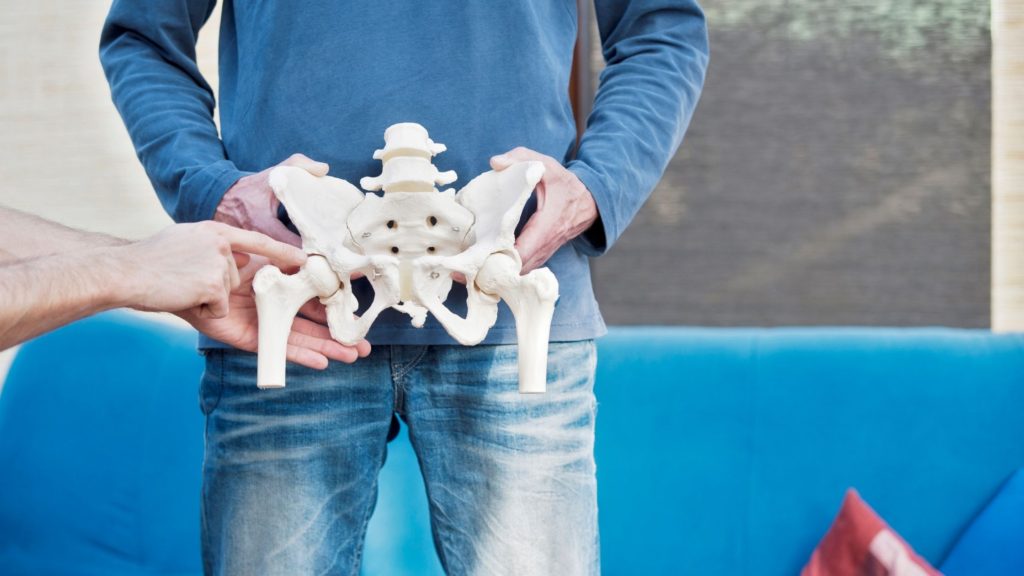
Osteoarthritis hip is a condition in which there is a problem with osteoarthritis in our hip. Normally, we all know that osteoarthritis commonly affects our knees, but it can also affect our hip joint for any reason.
But if you regularly follow some effective exercise with hip arthritis, it will help you get relief from this pain to a great extent and your life will become a little easier.
In this article, we will cover the most effective yet easy hip arthritis exercises to improve your quality of life.
- Easy Hip Arthritis Exercises You Can Do at Home
- How to Do Bridging Exercises for Hip Pain Relief
- Hip Flexion Stretch: Step-by-Step Guide
- Hip Swing Exercise to Improve Mobility
- Hip abduction adduction
- Straight Leg Raises: Strengthen Hips Safely with Arthritis
- Pillow press between the thighs for Weak Hip Muscles
- Standing Hip Extension Exercise (Reduces Stiffness)
- Hip flexion in standing
- Hip abduction in standing
- Hip Osteoarthritis: Causes, Symptoms & Treatment
- Cause of osteoarthritis hip
- Symptoms of hip arthritis
- How Physiotherapy Can Help Hip Arthritis (Evidence-Based)
- 7 Daily Habits to Reduce Hip Arthritis Pain
- Case study
- Key Takeaways: Best Exercises for Hip Arthritis
Easy Hip Arthritis Exercises You Can Do at Home
So before going into the hip arthritis exercises, let me tell you a few things: the main purpose of the exercise we will learn is to release the stiffness around our hip joint and strengthen the surrounding muscles.
So, for your ease, I divided all the exercises into two parts. One is the exercise which we have to do in lying down position and the other which we have to do standing.
In both these positions, there are both types of exercises, that is, the range of motion exercises, which help to ease the joint stiffness and then there are also strengthening exercises.
So, let us start with the bridging exercise.
How to Do Bridging Exercises for Hip Pain Relief
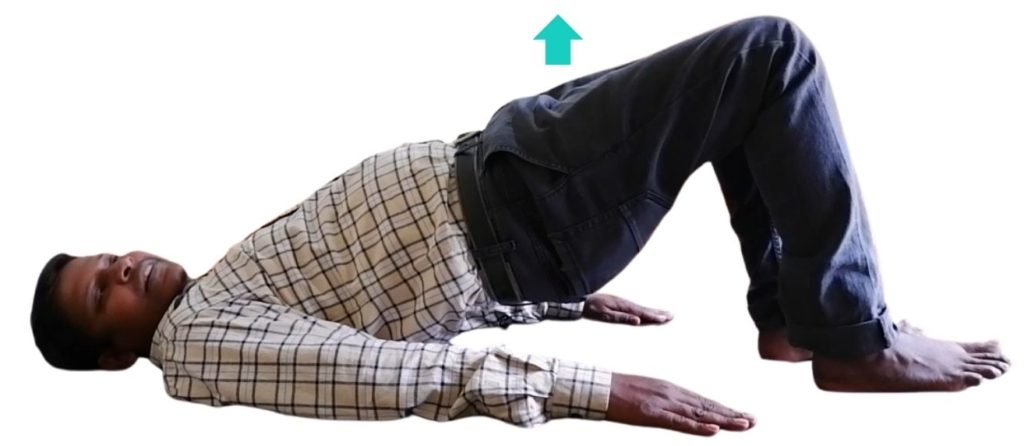
Let’s begin with the bridging exercise.
- First, lie down on your back and bend both knees.
- Once in position, lift your hips as high as possible, using your glutes and hamstrings to push your pelvis up towards the ceiling, just like in the figure you see.
- Hold this position for five seconds, slowly counting to 1, 2, 3, 4, 5, and lower your hips.
- Repeat this lift-and-hold exercise 10 to 15 times, focusing on the quality of your movement rather than the quantity.
Since the hip joint is a ball-and-socket joint, this exercise can help to improve hip mobility, stability, and strength.
Hip Flexion Stretch: Step-by-Step Guide
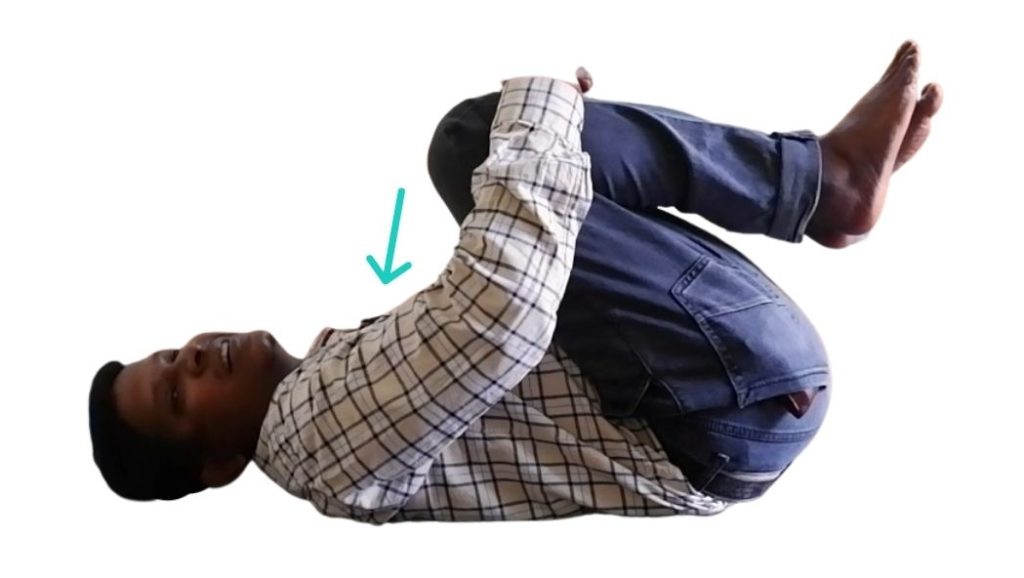
The next exercise is hip flexion which is performed while in the same position.
- Firstly, you should bend both knees and hips and then hold onto them with both hands. The accompanying figure shows you can then pull your knees towards your chest.
- Hold this position for 2 to 3 seconds before relaxing, then repeat the movement.
- By doing this, you will experience increased hip flexion, which is beneficial for maintaining mobility.
Hip Swing Exercise to Improve Mobility
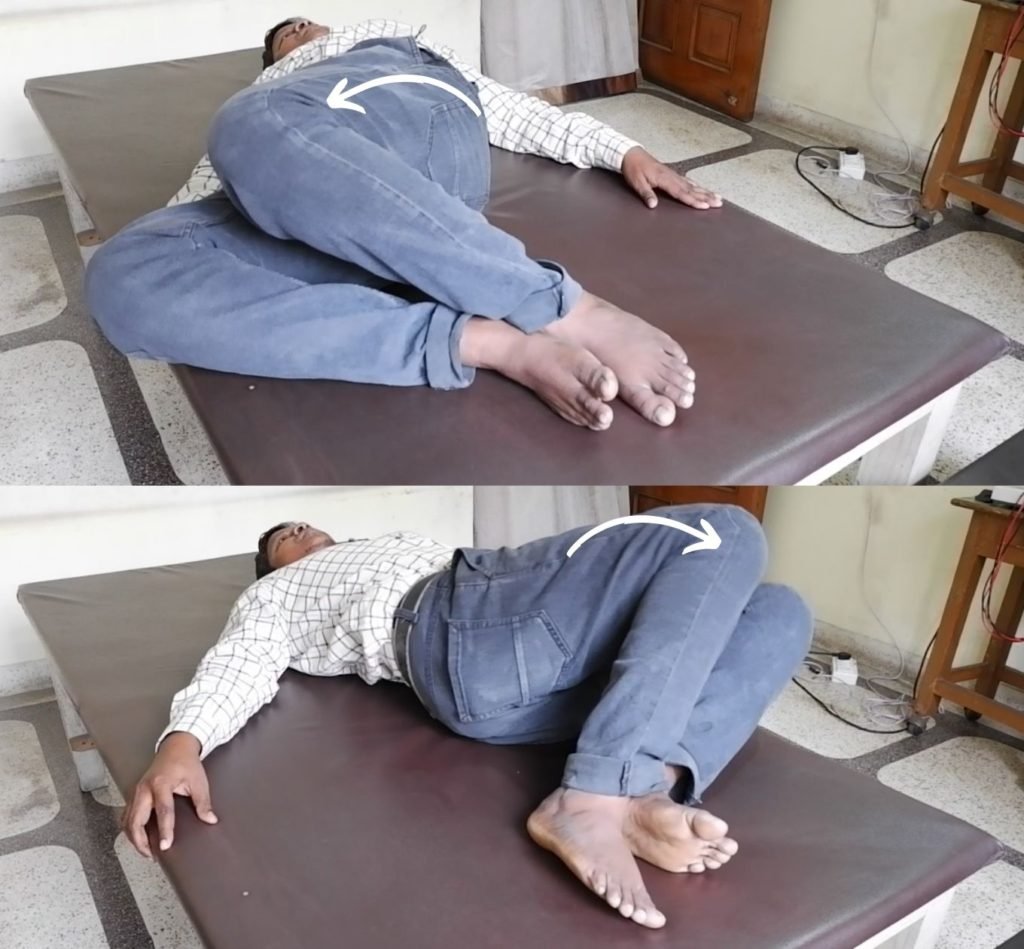
- Assuming the same starting position of lying flat on your back with both knees bent and feet placed flat on the floor.
- In this position, swing your legs to the right and then to the left, as demonstrated in the figure.
- You should perform this movement with ease, as if you were swinging your legs on both sides.
- Doing this exercise at least 15-20 times is recommended to improve joint flexibility. However, you may perform it more frequently for better results.
- Remember to perform the exercise smoothly and gradually increase the range of motion as your body becomes more accustomed to it.
Hip abduction adduction
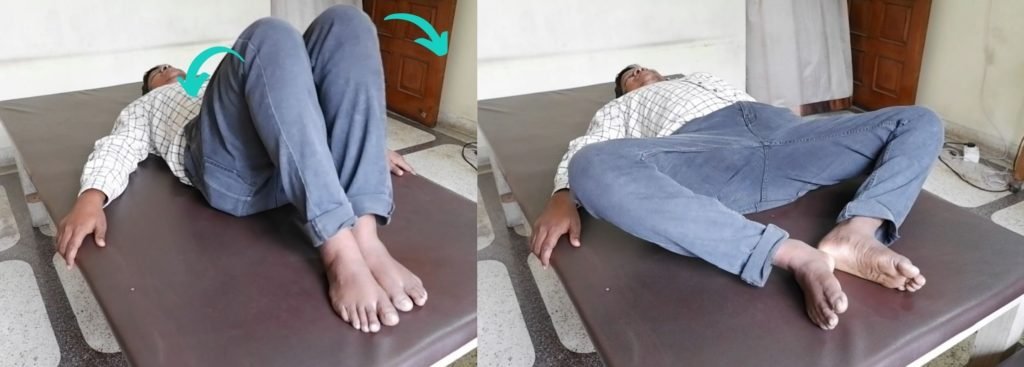
The next exercise is the hip abduction and adduction exercise.
- To do this exercise, you need to start in a seated position with your feet flat on the floor.
- Then, slowly lift your right leg and move it away from your body as far as you can comfortably.
- Hold this position for a few seconds before returning your leg to the starting position.
- Next, do the same with your left leg.
- This exercise can be done sitting or lying down, depending on your preference.
- You can repeat this exercise as often as you feel comfortable doing, as there is no specific count.
- This exercise is sometimes referred to as the butterfly exercise due to the motion involved in moving your legs in and out.
Also read: Excess Vit B intake Linked to Hip Fracture|Study
Straight Leg Raises: Strengthen Hips Safely with Arthritis
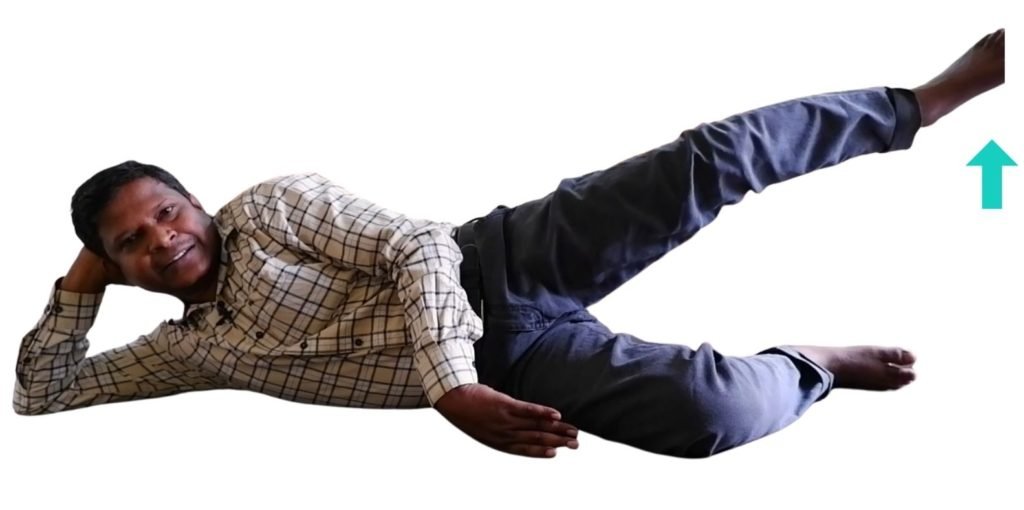
Flexibility exercises are important for those with hip arthritis, but strength training is equally important. Strengthening the muscles around the hip can help alleviate pain. To perform this exercise:
- Start by lying on your side and slightly bending your lower leg while straightening your upper leg.
- Next, lift your leg straight up without bending your knee, raise it to 30 degrees, and lower it back down.
- Repeat this motion several times, keeping your knee completely straight.
- Hold the leg up for 5 seconds each time before lowering it back down.
- You should also perform this exercise on the other side, doing at least 10 repetitions on each side.
- Doing this exercise will strengthen the muscles outside your hips, specifically the adductor muscles.
Pillow press between the thighs for Weak Hip Muscles
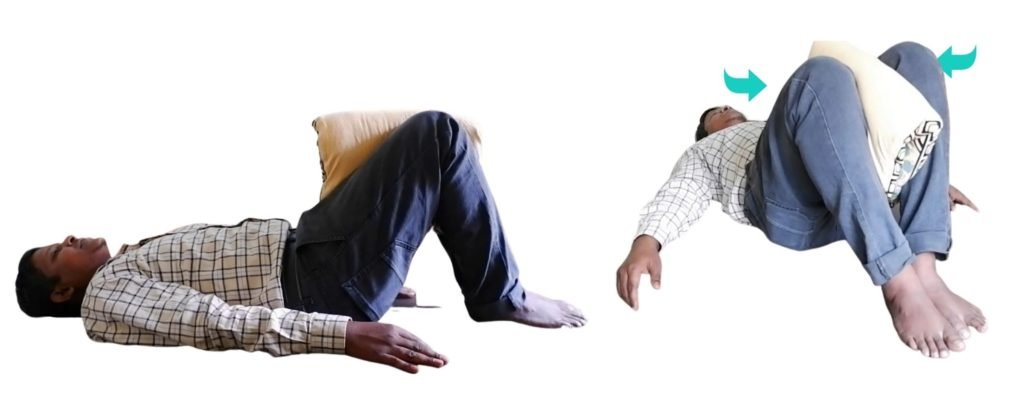
For the next exercise, you will need a pillow. You have the option to use one or two pillows, depending on your preference. Personally, I prefer using a single pillow, which I then fold to make it a little thicker.
- Sleep flat on your back with both knees bent and your foot placed flat on the floor.
- Place the pillow between your knees as instructed in the figure.
- Ensure your knee is bent, and press the pillow between your thighs.
- After holding it for a few seconds, relax it. Repeat this process by pressing in and then relaxing.
- Do this exercise 15 to 20 times in one session, but feel free to do more if you feel up to it. Remember, the more you do, the better the results will be.
Standing Hip Extension Exercise (Reduces Stiffness)
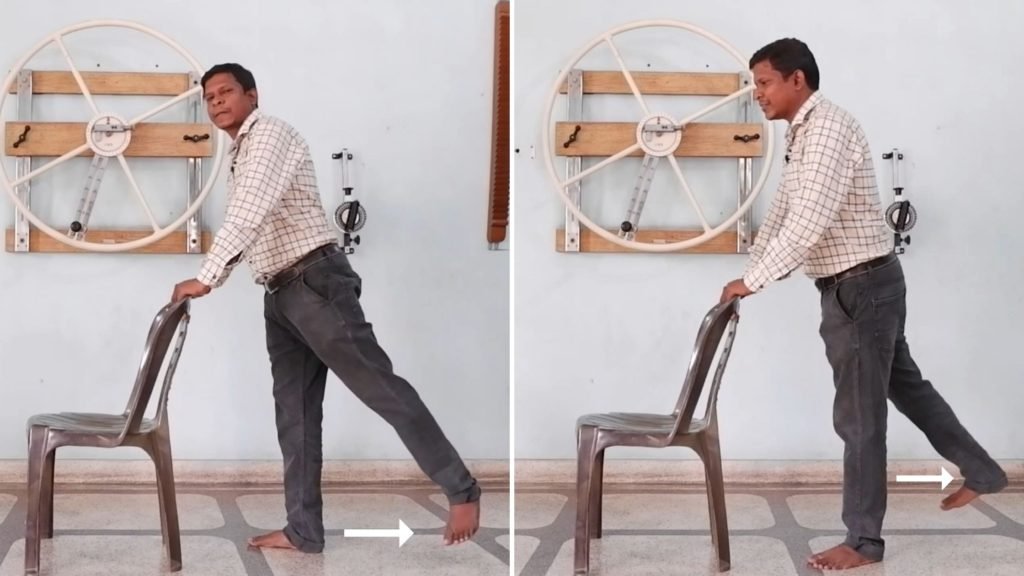
As we progress with our workout routine, it’s time to move on to the next exercise which is to be done in a standing position.
- To begin with, place a chair in front of you and stand facing it.
- Now, for this exercise, you need to move your legs back in a controlled manner while keeping your upper body straight.
- This hip extension exercise targets the muscles in the back of your hip and helps strengthen them.
- Now, repeat the same movement with your left leg.
- It’s important to alternate between both legs to ensure balanced muscle development.
- Remember to keep your movements slow and controlled, focusing on engaging your hip muscles. With regular practice, this exercise can help improve your hip strength and stability.
Hip flexion in standing
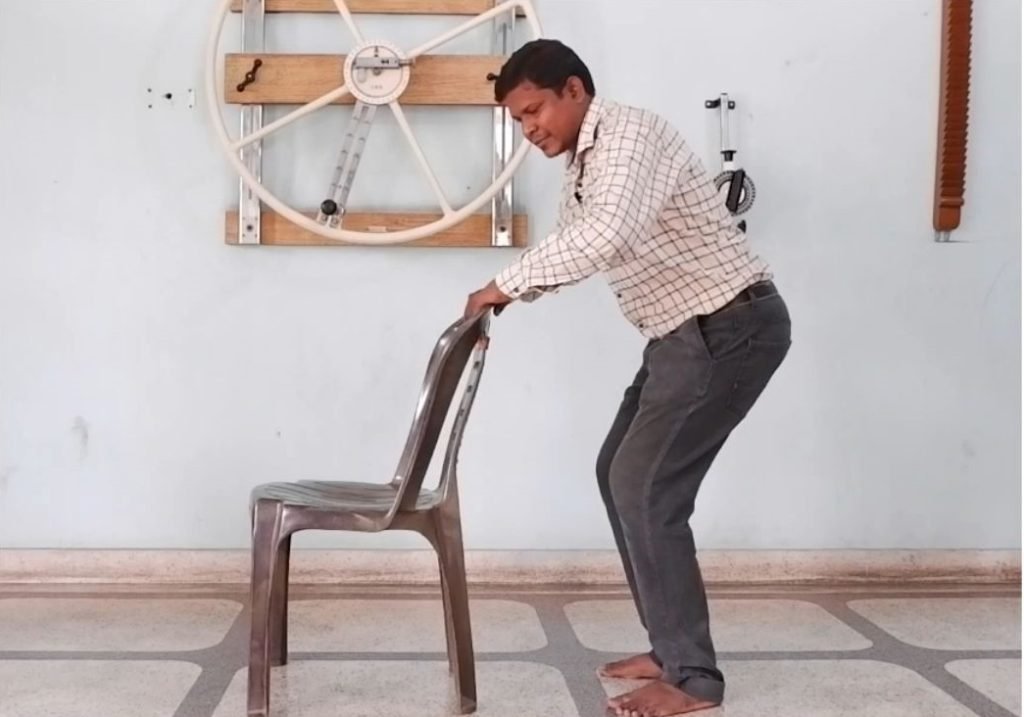
To add more detail, you can perform the hip flexion exercise while standing as well. This exercise serves as both a strengthening and flexibility exercise.
- Firstly, stand upright while holding onto a chair for support.
- Then, bend your knees slightly and bring one knee towards your chest, keeping your foot flat.
- As you lift your knee, you should feel a good flexion in your hip.
- Repeat this movement with each leg for at least 10 to 15 times, and up to 20 times if you feel comfortable doing so.
- Remember to also incorporate the other exercises I suggested earlier to ensure a well-rounded workout routine.
Hip abduction in standing
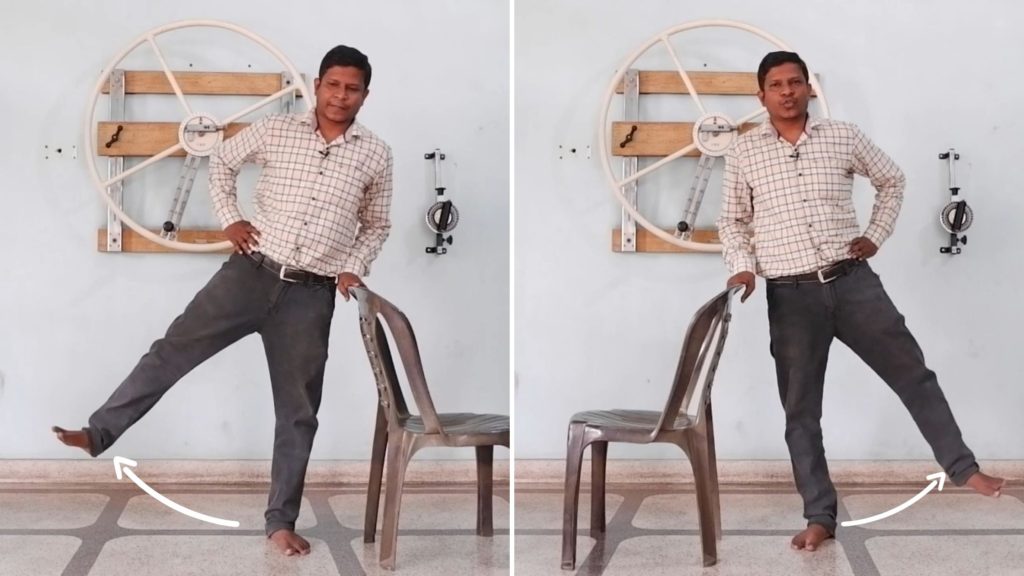
One of the exercises that can help alleviate hip arthritis is the hip abduction exercise, which can be done either lying down or standing up. For those who prefer the latter,
- It’s recommended to stand next to a chair or hold onto something stable to prevent falls, especially for the elderly.
- To perform the exercise, remove your legs from the body while holding onto the chair.
- Make sure to repeat this movement 10 times on one side and then switch to the other side for another 10 repetitions.
- Remember to take it slow and steady, and don’t forget to breathe throughout the exercise.
Hip Osteoarthritis: Causes, Symptoms & Treatment
Osteoarthritis of the hip is defined as the degeneration of articular cartilage and subchondral bone with compensatory bony proliferation and capsular fibrosis. Osteoarthritis is also known as Degenerative arthritis or degenerative joint disease.
The hip joint is a ball and socket variety of synovial joints. It is formed by the hip bone’s acetabulum and the femur (thigh) head. The acetabulum forms a socket in which the head of the femur forms the ball and fits in it.
The articular surface of the acetabulum and head of the femur consists of articular cartilage. Synovial fluid provides both joint lubrication and joint nutrition for the articular cartilage.
What goes wrong with Osteoarthritis hip?
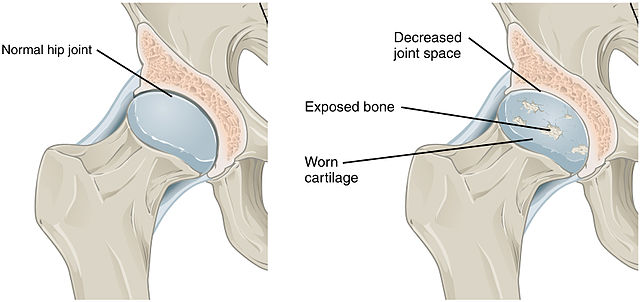
In osteoarthritis hip, articular cartilage and subchondral bone get eroded, making the joint surface rough. The bone surface becomes polished as there is a loss of protection from cartilage.
A synovial membrane undergoes hypertrophy. In the capsule and ligament occurs fibrous degeneration—all these results in decreased joint space.
Cause of osteoarthritis hip
The exact cause of hip osteoarthritis is still unknown but many factors contribute to it.
- Genetics- runs in the family.
- Ageing: We often associate osteoarthritis hip with old age to link the cause with age.
- Secondary to pre-existing factors/diseases like Coxa valga/vara, Hip anteversion/retroversion. Congenital dislocation of the hip, Fracture neck of femur, Slipped femoral epiphysis. These factors affect the hip joint’s normal alignment, thereby increasing stress or overload on it.
Predisposing factor
These are factors that contribute to the cause of osteoarthritis of the hip joint. It directly or indirectly causes abnormal stress or load in the hip joint.
- Limb length discrepancy.
- Knee deformity such as bow leg/genu varum.
- Increased body weight.
- Muscle weakness around the hip.
Symptoms of hip arthritis
1: Pain
- Pain is of insidious onset.
- Pain in the groin region and trochanteric region (outer side of the hip) and referred down the anterior aspect of the thigh to the knee.
- The patient experiences pain following activities such as walking, running and jumping.
- Active weight-bearing pain, such as Squatting, Forward bending. Stair climbing.
2: Muscle spasm occurs in the adductor, flexor and lateral rotator muscles.
3: Deformity is flexion, adduction, and lateral rotation.
4: Muscle weakness occurs in all muscles. The most functionally restricting is the weakness of the extensor and abductor.
How Physiotherapy Can Help Hip Arthritis (Evidence-Based)
The sufferer of osteoarthritis hip goes through tremendous pain and disability. Pain in the hip limits daily activity, and one stops going out for shopping or visiting a nearby club. This limitation results in psychological stress and frustration.
The disease process degree of joint degradation and joint space narrowing is classified under three grades: grade I, grade II, and grade III. The classification of each stage is done depending on how severe the pain is. And physiotherapy treatment plan is based upon this.
Grade-I
The acute stage is characterised by severe pain, spasms, and reduced endurance.
X-ray report reveals doubtful narrowing of joint space and possible osteophytes.
Physiotherapy treatment:
Pain is the main concern during the acute stage, and in physiotherapy, there are various modes to control pain.
- TENS (Transcutaneous Electrical Nerve Stimulation) is applied for pain referring up to the knee joint.
- IFT (Interferential Therapy) application is very effective for pain and spasm around the hip and groin region.
- In addition to the above, heat therapy will also benefit from pain and swelling. We can apply heat therapy by means of Infrared lamp or hot fomentation.
Exercises
Mgmt – stretching exercise (hip joint capsule stretching)
Grade-II
In Grade II or subacute phase, the main complaint is morning pain and stiffness/ night pain/ marked restriction of hip joint movement & activities.
The X-ray of the hip at this phase clearly shows definite osteophytes and a slight narrowing of the joint space.
Physiotherapy treatment: All the points for the pain that apply for Grade I are also valid for this grade.
Exercises: Management – capsular stretching and strengthening exercise. Use of a walking aid.
Grade-III
Grade III has a sign of severe pain/disability with joint instability. X-ray shows large osteophytes with marked narrowing of joint space. By this time, there will be definite deformity with joint instability.
Physiotherapy management: The patient has to depend on a walking aid for normal ambulation and activity.
Definitive management: Endurance exercise.
There is marked degradation in & around the joint with joint space narrowing. So, surgery is the definitive management. And the only option in this phase is hip replacement surgery.
7 Daily Habits to Reduce Hip Arthritis Pain
- Weight reduction: Keep a record of your weight. Try to keep your weight under control. If required, you may join weight reduction sessions/classes in your town for professional guidance.
- Minimise all the weight-bearing activities that involve hip flexion. Like, avoid sitting cross-legged, and avoid going to the toilet where you need to squat.
- During winter or cold weather, protect the joint from exposure to cold by wrapping it with warm clothes. Use heating pads or a hot water bottle to warm muscles and reduce pain.
- You may use an Infrared Lamp for pain reduction by heating. Read this article for guidance on how to use Infrared lamp.
- The patient can also use a portable TENS machine with them, which is very easy to use and helps in pain reduction.
Case study
A 65-year-old lady complains of pain in her right groin, knee and buttock. She had been suffering for three years, but it had gradually got worse. It has become more frequent over the last 6 months.
There is no history of recent falls or injuries. She described her pain as a deep, dull ache type. The pain was at its most intense in the mornings when she first got out of bed, and again in the evening after the day’s activity. She has been under medication for the last two years.
Key Takeaways: Best Exercises for Hip Arthritis
All these exercises are necessary, which is specifically for hip-joint osteoarthritis and along with it, if you do aerobics, then it will be better which you can do morning walking or morning jogging or If possible, you can do swimming, cycling, and static cycling.
In cycling, there’s the movement of both the knee and hip. And you can also do outdoor cycling if it is possible, which helps in the strengthening of your hip joint as well as improves muscle flexibility over there.
It helps improve the surrounding blood circulation, which is very important for the health of the joint cartilage there.
Often, along with the hip joint, there is also a problem of osteoarthritis in the knee, and if I say, more than the hips, osteoarthritis is more common in the knees, sometimes both co-exist.
So, for knee OA, I have already made a good article about the effective exercises for knee osteoarthritis, you can read it by going here.
Did these exercises help you? Share your progress in the comments below! For more personalized advice, consult a physiotherapist near you.
Keep Reading: Turmeric can Help in Osteoarthritis Knee Pain|Study
FAQ
The author is a physiotherapist who has been practising for the last 17 years. He holds a Bachelor's in Physiotherapy (BPT) from SVNIRTAR (Swami Vivekananda National Institute of Rehabilitation and Research), one of the prestigious physiotherapy schools in India.
Whatever he learns dealing with his patient, he shares it with the world through blogs and e-books. He also owns a YouTube channel, "Sunit Physiotherapist" with over 8 lakh active subscribers. Here, he shares everything he gets to learn serving the patient.
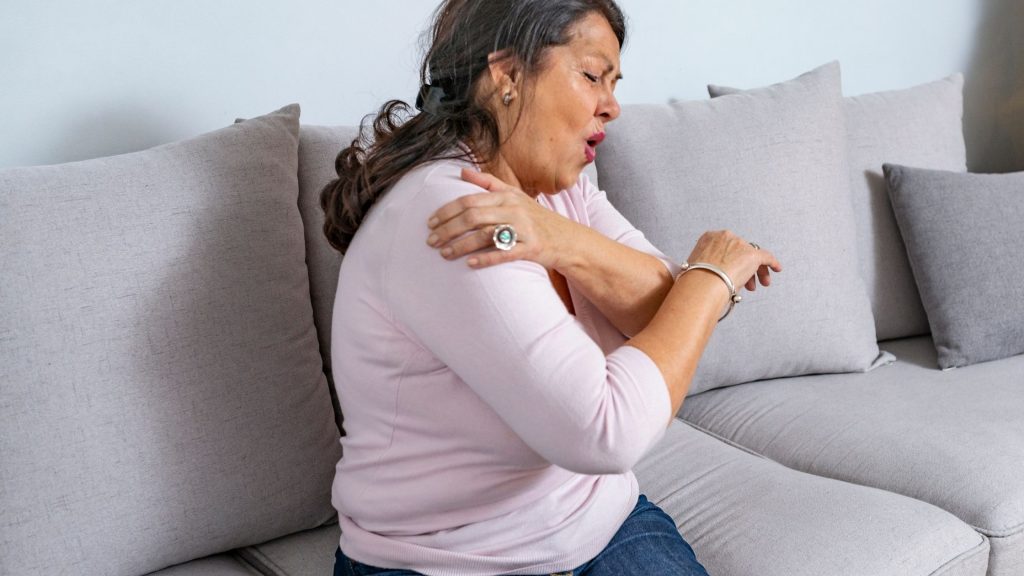

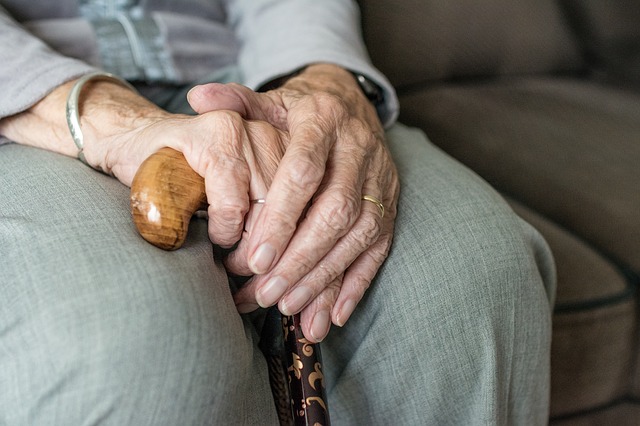
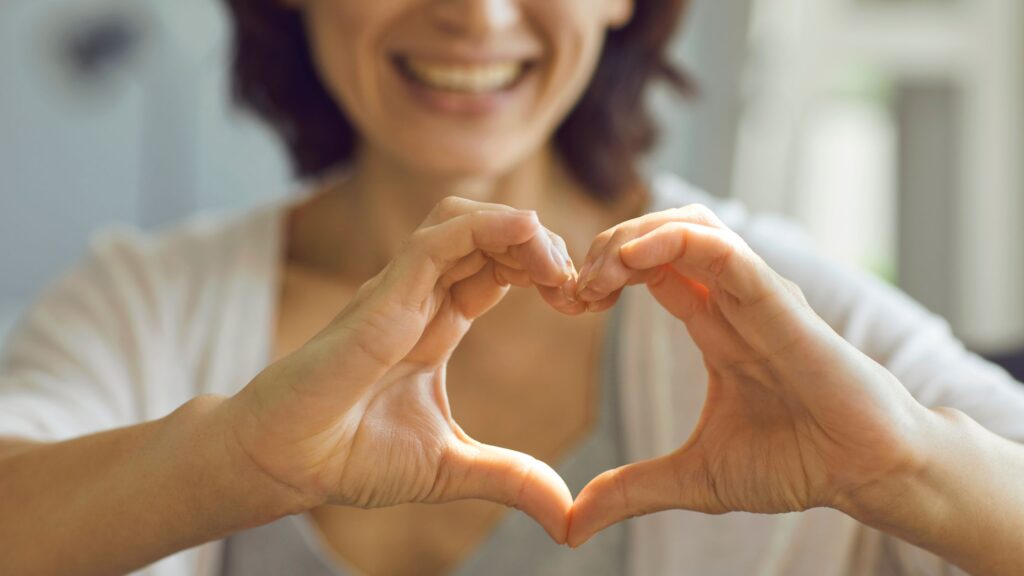
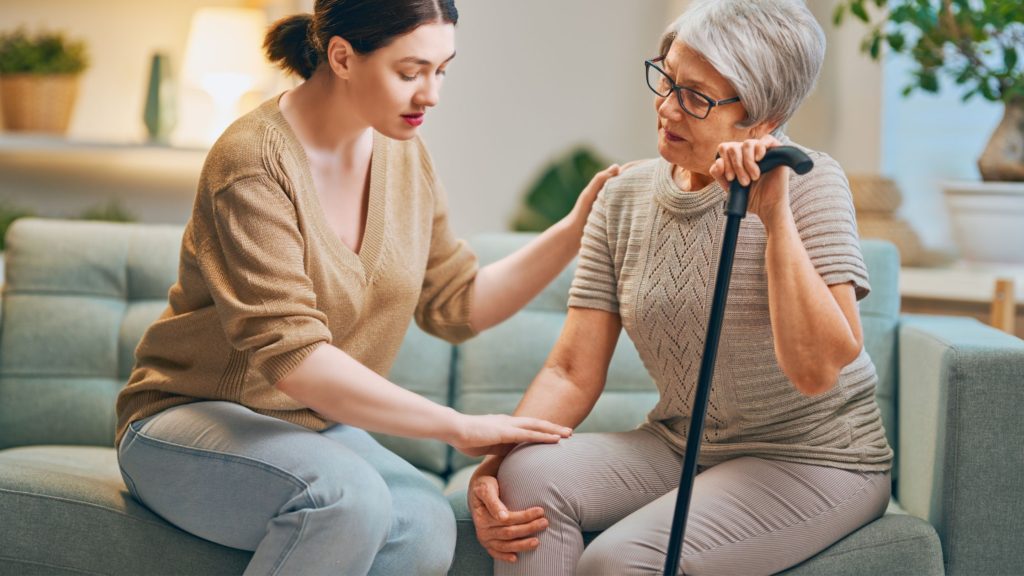
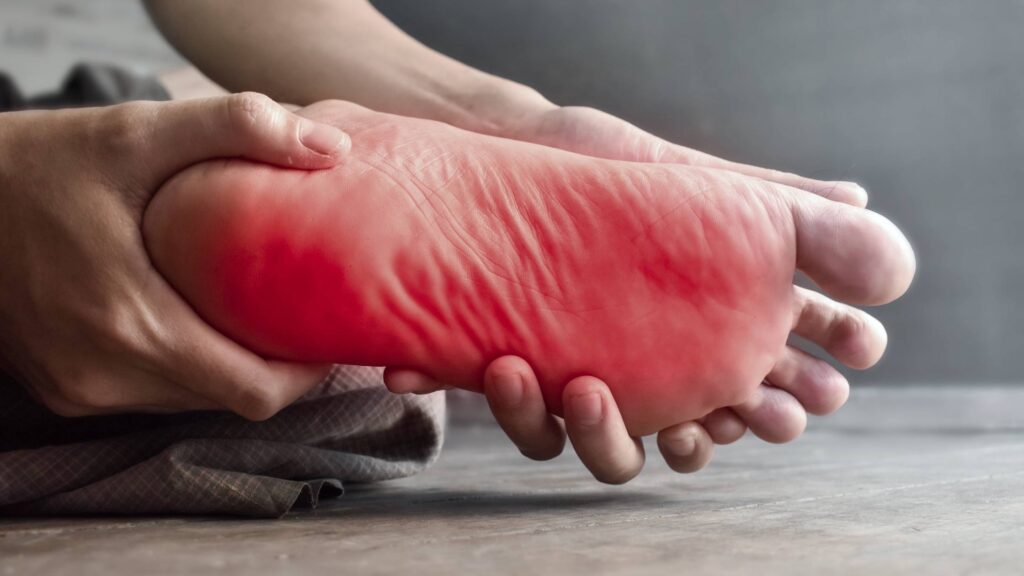
Pingback: Rheumatoid arthritis vs osteoarthritis: which arthritis is worse? - Physiosunit
Pingback: 9 Best Knee Rheumatoid Arthritis Exercises for Stiffness, Pain - Physiosunit